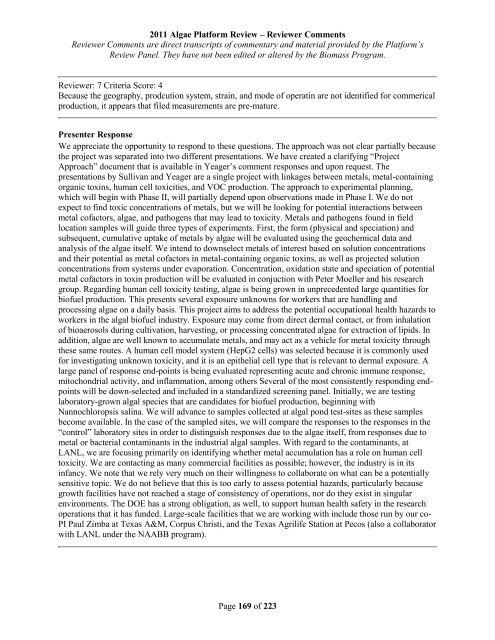Reviewer Comments - EERE
Reviewer Comments - EERE
Reviewer Comments - EERE
Create successful ePaper yourself
Turn your PDF publications into a flip-book with our unique Google optimized e-Paper software.
2011 Algae Platform Review – <strong>Reviewer</strong> <strong>Comments</strong><br />
<strong>Reviewer</strong> <strong>Comments</strong> are direct transcripts of commentary and material provided by the Platform’s<br />
Review Panel. They have not been edited or altered by the Biomass Program.<br />
<strong>Reviewer</strong>: 7 Criteria Score: 4<br />
Because the geography, prodcution system, strain, and mode of operatin are not identified for commerical<br />
production, it appears that filed measurements are pre-mature.<br />
Presenter Response<br />
We appreciate the opportunity to respond to these questions. The approach was not clear partially because<br />
the project was separated into two different presentations. We have created a clarifying “Project<br />
Approach” document that is available in Yeager’s comment responses and upon request. The<br />
presentations by Sullivan and Yeager are a single project with linkages between metals, metal-containing<br />
organic toxins, human cell toxicities, and VOC production. The approach to experimental planning,<br />
which will begin with Phase II, will partially depend upon observations made in Phase I. We do not<br />
expect to find toxic concentrations of metals, but we will be looking for potential interactions between<br />
metal cofactors, algae, and pathogens that may lead to toxicity. Metals and pathogens found in field<br />
location samples will guide three types of experiments. First, the form (physical and speciation) and<br />
subsequent, cumulative uptake of metals by algae will be evaluated using the geochemical data and<br />
analysis of the algae itself. We intend to downselect metals of interest based on solution concentrations<br />
and their potential as metal cofactors in metal-containing organic toxins, as well as projected solution<br />
concentrations from systems under evaporation. Concentration, oxidation state and speciation of potential<br />
metal cofactors in toxin production will be evaluated in conjuction with Peter Moeller and his research<br />
group. Regarding human cell toxicity testing, algae is being grown in unprecedented large quantities for<br />
biofuel production. This presents several exposure unknowns for workers that are handling and<br />
processing algae on a daily basis. This project aims to address the potential occupational health hazards to<br />
workers in the algal biofuel industry. Exposure may come from direct dermal contact, or from inhalation<br />
of bioaerosols during cultivation, harvesting, or processing concentrated algae for extraction of lipids. In<br />
addition, algae are well known to accumulate metals, and may act as a vehicle for metal toxicity through<br />
these same routes. A human cell model system (HepG2 cells) was selected because it is commonly used<br />
for investigating unknown toxicity, and it is an epithelial cell type that is relevant to dermal exposure. A<br />
large panel of response end-points is being evaluated representing acute and chronic immune response,<br />
mitochondrial activity, and inflammation, among others Several of the most consistently responding endpoints<br />
will be down-selected and included in a standardized screening panel. Initially, we are testing<br />
laboratory-grown algal species that are candidates for biofuel production, beginning with<br />
Nannochloropsis salina. We will advance to samples collected at algal pond test-sites as these samples<br />
become available. In the case of the sampled sites, we will compare the responses to the responses in the<br />
“control” laboratory sites in order to distinguish responses due to the algae itself, from responses due to<br />
metal or bacterial contaminants in the industrial algal samples. With regard to the contaminants, at<br />
LANL, we are focusing primarily on identifying whether metal accumulation has a role on human cell<br />
toxicity. We are contacting as many commercial facilities as possible; however, the industry is in its<br />
infancy. We note that we rely very much on their willingness to collaborate on what can be a potentially<br />
sensitive topic. We do not believe that this is too early to assess potential hazards, particularly because<br />
growth facilities have not reached a stage of consistency of operations, nor do they exist in singular<br />
environments. The DOE has a strong obligation, as well, to support human health safety in the research<br />
operations that it has funded. Large-scale facilities that we are working with include those run by our co-<br />
PI Paul Zimba at Texas A&M, Corpus Christi, and the Texas Agrilife Station at Pecos (also a collaborator<br />
with LANL under the NAABB program).<br />
Page 169 of 223




